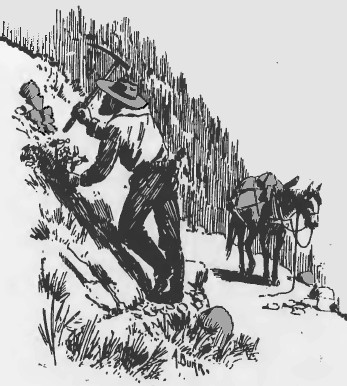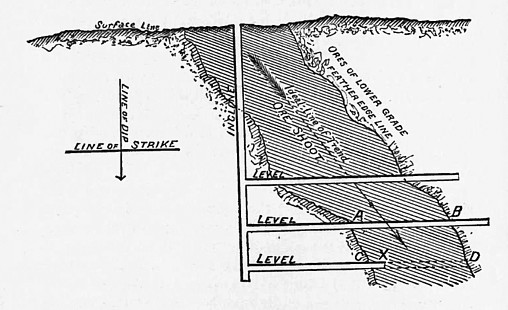Surface indications may be described as: Form of ground, color, outcrop, decomposed and detached mineral, mineral deposits from springs, altered or peculiar vegetation and other similar guides. A hard quartz outcrop often stands up like a wall and is traceable for miles. The Rainbow silver bearing lode of Butte, Montana, stood 20 feet above the surface. Soft minerals, such as clay, are cut into and sunk below the surrounding level. Deposits of Kaolin or China clay are usually so found.
Any special bright coloration of the rocks of a district merits investigation. Copper gives green, blue, and red stains; iron, red or brown ; manganese, black; lead, green, yellow or white; cobalt, pink; cinnabar or quicksilver, vermilion. The nickel deposits of New Caledonia were made known to the world by the explorer Gamier in 1863, his curiosity having been aroused by the delicate green coating given the rocks by an ore containing water, quartz, nickel and magnesium. Hard beds of shale decompose on the surface into soft clay, and a still more noticeable change is the conversion of ores containing sulfur into oxides. This chemical change causes the goethite gossan or "iron hat," for which token of underlying wealth the prospector should be eternally watchful. This alteration may extend downward four or five hundred feet from the surface, but in such cases the true weathering has ceased long before the limit of discoloration is reached, and the change of substance is due to the filtering of surface waters through the vein. Gossan varies greatly in its nature. Galena becomes anglesite, cerussite, pyromorphite and mimetite. Copper pyrite changes into native copper, melaconite, cuprite, malachite, chessylite, or perhaps into a phosphate, arsenate, or silicate of the metal. Carbonate of manganese gives the black oxides and silver sulfide ores are, after weathering, known as native silver, kerargyrite and embolite.
The ore in the gossan is very generally more valuable than it will be below, and this is especially true of gold and silver ores. The gold having been set free from the close embrace in which the iron pyrite held it previous to the latter's oxidation, it is now readily caught by quicksilver. Silver under similar conditions becomes chloride, and likewise amalgamates without difficulty. Seams containing native sulfur often show no trace of that element on the surface, having weathered into a soft, white, gray or yellowish-white granular, or pulverulent, variety of gypsum. Veins of asbestos often decompose into a white powder found in the crevices of the rocks ; fibrous asbestos existing in the interior. Petroleum shows in an iridescent film upon still pools, and the odor is a sure guide to its nature. A "dipping-needle" is valuable to the prospector on the lookout for iron ore; by its use he may discover masses of magnetic ore and trace their extent. As he carries the compass over the ground the needle dips toward any iron mass he approaches; directly over the ore it becomes vertical.
In a wilderness country strength of body and endurance are important qualifications. The prospector must, moreover, have such general knowledge of geology and mineralogy as to be able to recognize all valuable minerals and confirm his conjecture by simple tests. Pick, shovel and pan must be handled skillfully, while the rifle, shotgun and paddle must also be understood. For in the unsettled parts of the country the traveler must even yet rely to some extent upon the fish and game he may be able to secure, and every old prospector becomes a trained hunter and camper. Knowing how to bake bread is sometimes more valuable than much mathematics; ability to build a rough boat is often the one hope of salvation. In sinking a short shaft in a sunny country a large mirror, inclined at a suitable angle over the shaft, will give sufficient light. Lodes or veins following the general trend of the auriferous quartz are much more likely to be rich than are those that cross it. Gold is never distributed evenly in veins, though it may be in great beds of low grade material ; but more often rich areas alternate with barren portions. Where quartz veins are small and the rich pockets separated by wide intervals of poor gangue, the gravel of the district will usually be similar in character. As this condition obtains in the upper Yukon district as far as the gravels are concerned, it will probably be found to hold good for the quartz leads, when they shall have been discovered.
The more nearly the gold formation approaches to the crystalline schists, the poorer will the quality of the gold be through the larger percentage of silver found in it. In slates the proportion may be 22 gold to 1 silver; in schists it has been known to be a ratio of 1 to 1. With the discovery of valuable gold-bearing gravel on the bare hillsides of the Northwest, a vast region has been added to the area the prospector may explore to advantage. No experience acquired in ordinary American placer grounds is likely to be of much use in detecting these higher gold-bearing gravels of the Yukon, but they appear to be somewhat similar in character to the New Zealand terraces. Terrace-prospecting requires perseverance and the use of some brains, as it is infinitely harder than creek-prospecting. These terraces or benches are the remains of old river beds. The whole bench must be carefully scanned over because the gold is quite as likely to be in one part as in the other. Sometimes it is in half a dozen different layers one above the other. Sometimes the old river terraces are entirely covered by landslides, and the majority of such deposits are not likely ever to be found, as it is almost impossible to guess at locations.
Gold was first discovered in California in 1848 by the superintendent of a sawmill who saw it glistening in the flume. Similarly gold was discovered in both Australia and Brazil by the purest chance. Had not a tree been uprooted by the wind the vast deposits of soft hematite iron ore in the Biwabic iron mines of the Mesabi range, Minnesota, might have remained unknown for many a long year to come. In the desolate region to the northward of Lake Huron great stores of nickel ore exist. These mines, which may some day regulate the price of the metal all the world over, were exposed in a railway cutting; no one dreamed of their existence. The Redington quicksilver mine in California was discovered by some road makers. Tradition relates that the enormously rich silver mines of Potosi, in Bolivia, were discovered by the accidental uprooting of a bush having spangles of silver ores attached to its roots. This was in 1538, and two hundred years later a similar streak of luck revealed the wealth of the Catorce district of Mexico, from which in thirty years, ore to the value of $35,000,000 was taken.
Moreover, the search for one mineral often leads to the discovery of another. The Comstock lode was first worked for gold, and the miners threw away the black sulfide of silver worth $3,000 to the ton. The Broken Hill mine in Australia was claimed as a tin deposit by its finder; it is now the greatest silver producer in Australasia. Such instances could be multiplied almost indefinitely, chance entering into a majority of mineral discoveries. On the other hand, it has happened, not infrequently, that purely scientific deductions and calculations have brought to light stores of mineral wealth. Certain minerals are likely to be found associated with each other. Cassiterite goes with boron and tourmaline, topaz, fluorite and lithia-mica; all containing fluorine. It is also found with wolfram, chlorite and arsenical pyrites. Magnetite is often accompanied by rocks containing garnet, epidote and hornblende. Sphalerite and galena may occupy the same vein, which is likely to be of barite or heavy spar. Much galena carries silver. Gold is associated with many metallic sulfides such as iron, magnetic, and copper pyrites, mispickel, galena, blend, stibnite and tetrahedrite. Gypsum accompanies salt.
Continue on to:
How To Test For And Recognize Minerals
Return To:
Gold and Silver Prospecting Basics


